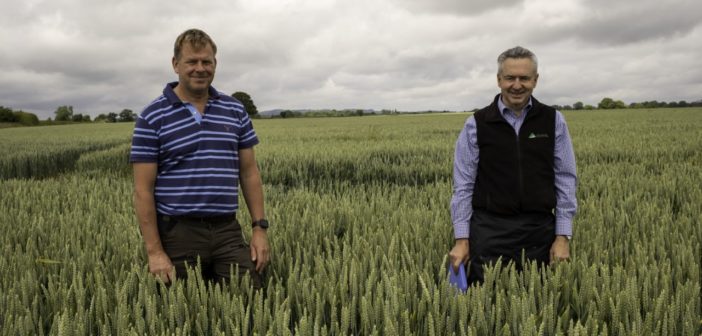Hyking, a hybrid winter wheat from Elsoms, could be the second wheat or winter barley replacement many growers have been searching for.
Across 105 hectares (260 acres) that runs from well-bodied clay soil into black and red sands, Ben Linington hopes to give his crop of Hyking hybrid wheat a fair test. Having dropped winter barley after harvest 2020 because the margin after input costs was often insufficient to make it financially worthwhile, he has high expectations that Hyking will be a worthy replacement.
“It’s the reported drought tolerance of Hyking that persuaded me to try it. Second wheats on our sands struggle to average 7.4 t/ha (3 t/ac) whereas I’m expecting the Hyking to yield close to 8.6 t /ha (3.5 t/ac),” Mr Linington explains.
This is the third consecutive season he has grown one of the few commercially available varieties of hybrid wheat at the Flichity Estates Partnership at High Hatton in north Shropshire. The previous two crops were both mired by bad weather meaning it was unfair to use these seasons as the basis for an assessment.
“Autumn 2019 was one of the wettest on record while the spring and summer of 2020 was one long drought. Aside from a wetter than average winter, this season is more typical, so I’m expecting it perform, but the higher seed costs, which are roughly three times that of a standard wheat crop, means it needs to do just that if it is to sustain my interest,” he confirms.
As a French-bred variety from plant breeder ASUR, a member of the Saaten Union Group, it’s tall at 91cm and consequently it received fractionally more plant growth regulator than the varieties Graham or KWS Siskin that complete the wheat area at High Hatton.
“Across the farm the wheats were treated according to disease pressure and weather outlook, but this has meant that they have been fairly well looked after. The Hyking received no more fungicide than our conventional wheats, but it is significantly cleaner which suggests its disease resistance has held up well; its yellow rust score of 7 is respectable and certainly not something other growers should be concerned about,” he says.
As Hyking is not on the AHDB Recommended List, the variety data sheet produced by UK marketing agent Elsoms has been the basis for management decisions. A quoted yield of 110% of controls – 4% higher than KWS Siskin – and an untreated yield of 126% – 12% higher than Siskin – suggest it has strong potential. Overall agronomic scores are better too with the exception of yellow rust for which Hyking has a rating of 7 (see table).
“The crop looks well despite a horribly wet and unfavourable winter, but there are a couple of points that set it apart from other wheats on the farm,” says Ben.
“In its favour is its stronger early vigour; once it is established it moves quickly which we hope to use to our advantage. It is also earlier to mature – closer to that of winter barley – which helps with the harvest workload,” Ben says.
“However it doesn’t like wet ground, which partly explains why we have sown it on light sands where we hope its greater drought tolerance will be its main strength. We have also seen it show greater susceptibility to manganese deficiency than the other wheats following the wet end to winter. This, combined with the frosts in April, led to the leaf tips being scorched, at the time I was fearful that we could lose a lot of tillers, but it has come through well,” he adds.
“The nitrogen regime mirrored our other wheat crops although it was applied earlier due to being slightly further forward and the expectation that it will ripen up to a week earlier. Disease control consisted of a basic T0 and T3 based on older chemistry with a higher input regime at T1 and T2 – the same as applied to both Graham and Siskin” he concludes.
Hyking’s agronomics compared*
| Yellow rust | Brown rust | Septoria tritici | Treated height (CM) | |
| Hyking | 7 | 9 | 6 | 91 |
| KWS Siskin | 9 | 7 | 5 | 85 |
| Gleam | 4 | 8 | 7 | 91 |
* Saaten Union UK own data from Cowlinge, Suffolk, 2019




